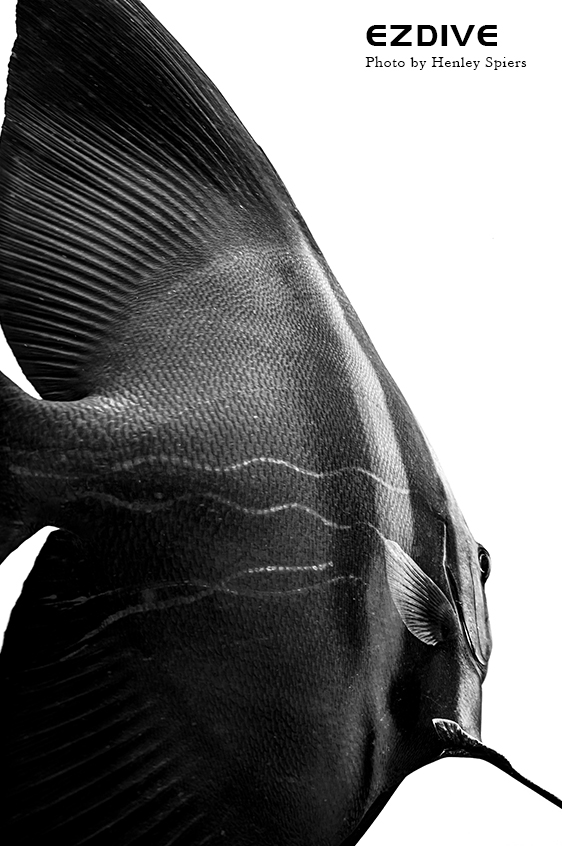There are three types of black and white photos, and only two of them are worth aspiring for. In this issue, Henley Spiers shares his black and white underwater photography technique with EZDIVE readers.
Text & Photo | Henley Spiers
The first and least interesting is black and white as a means for disaster recovery, and it’s vitally important to steer away from this genre and recognise when we are falling into its trap. We’ve all been there, staring at an image in our editing suite, wishing for it to have greater impact. It might be because the moment or encounter was special to us, it might be for any number of other reasons, but it leads us to convert a mediocre picture into black and white. The false belief then ensues that its merit has been enhanced and that the image is all of a sudden more “artistic”. I have fallen victim to this deception on many occasions, but it’s important to recognise when we are indulging in such delusions and walk away. A bad picture is not converted into a good picture through the magic of absolute desaturation. Black and white can lift imagery into the realm of fine art, but it must start with solid foundations. In other words, black and white is not a lifeguard for pictures which would otherwise sink.
Now that we’ve got that out of the way, let’s focus on the type of black and white photographs which merit our time and attention. Any good picture deserves consideration in monochrome, and for every successful image, I will always ask myself if it would be better suited to greyscale. Some photographs lose their soul without colour, but many will also have appeal in monochrome – although this may change our reaction and the focus of the composition. Herein we find the second category, pictures which look good in both colour and black and white, take jellyfish lake images on page 73 as an example: to my eye, they are both pleasing, on some days I have a mild preference for the colour, on others the monochrome feels more powerful. A black and white conversion was worthwhile, and it’s good practice to at least consider all of our favourite images in black and white.
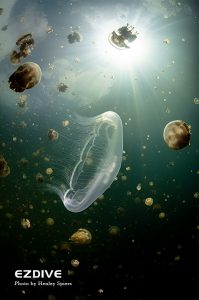
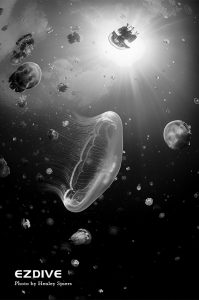
The last, and most elusive, are the pictures which are elevated to a higher plane by black and white. In my experience these are rare, but it is both the loftiest and most worthy ambition for monochrome. Take for example the photograph of the cormorant diving down on a school of fish below, black and white makes this picture far more powerful than it is in colour. The storytelling and emotion are starkly understood, and a surrealistic element is added as we wonder whether the bird is underwater or in the air.
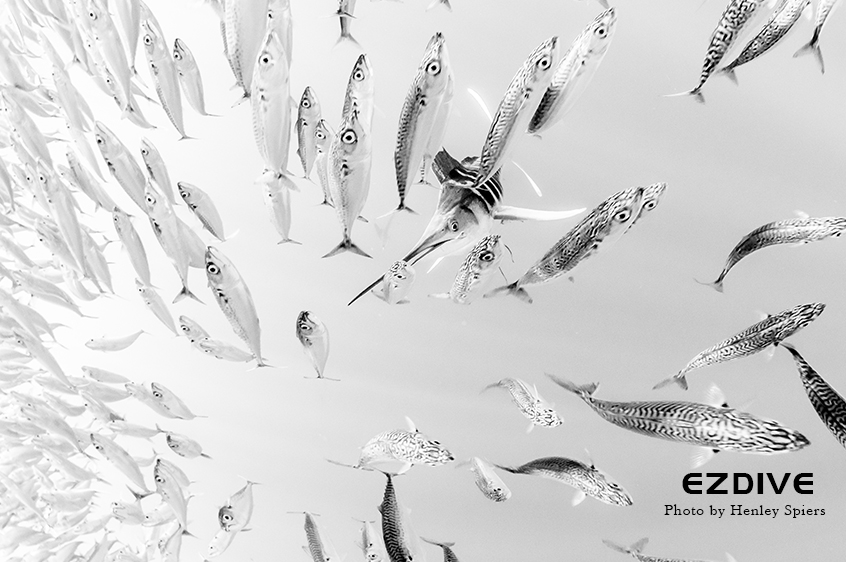
The arbitration of these three types is worth keeping in mind when dealing with black and white images underwater, but now let’s move onto more practical advice for shooting and editing. Black and white imagery is still controlled by colour, with each colour channel rendered as particular shade of grey. Although we should shoot in RAW format whenever possible, we can opt for a monochrome preview at the moment we make a photograph. With practice however, this preview will no longer be required as you learn to see how a particular scene may be translated in black and white.
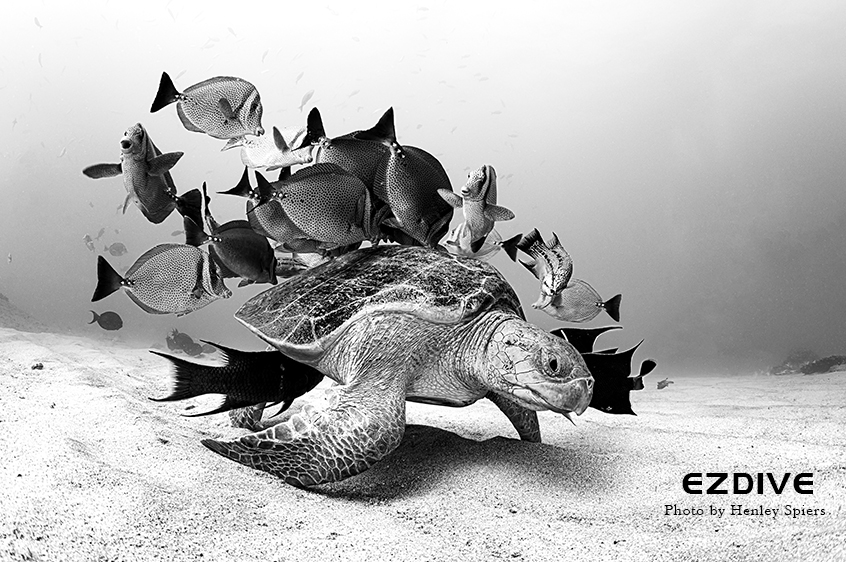
Solid blocks of different colours present exciting possibilities, for instance, a green turtle against blue water can be transformed into a vividly detailed shell against jet black. Indeed, some of the most impactful monochrome images are created when looking into the water column, rather than against the backdrop of a reef. Whether it’s in the moment, or after the fact, it’s worth asking ourselves what it is which is special about an image. If the answer is the colours, then it may not be the best candidate for a black and white conversion. If it’s the form and texture give it appeal, then monochrome can bring more bite to these elements. A tightly grouped school of eagle rays, each with unique spotting, is enhanced by black and white – in the final image we feel both the connection of the group, but also appreciate the unique shading and starry tattoos on the back of each individual.
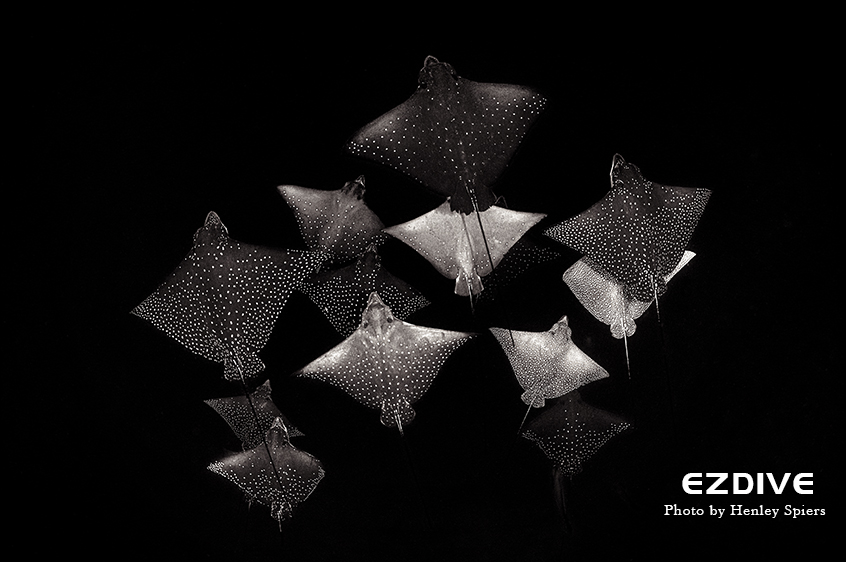
Just like with human portraits, black and white can reinforce the emotion of a frame. When the noise of colour is hushed, our full attention goes into the feeling of a subject and scene. The roar of a ribbon eel seems ferocious and prehistoric in monochrome, its character drawing the viewer in. This picture is also a reminder that it’s a misconception to always think of black and white as the domain of only wide-angle images. Many macro photographs have their heart in the spectacular colour of the subjects or backgrounds, but there is still opportunity to find compelling monochrome visions in the world of small things.
Once the moment is captured in-camera, bringing out its best in the digital darkroom is the next step in the chain. I create all of my monochrome conversions in Adobe Lightroom. With colour being a vital part of the final result, it’s important to ensure you are happy with the white balance for the picture. If everything is uniformly blue, it will be very difficult to create separation between the various elements of the image. After hitting the black and white button, the editing work really begins and the first place to head are the colour channels (where you would usually find hue, saturation and luminance on a colour edit). This is where the magic happens and where one truly appreciates the worth of colour when it comes to black and white. Try moving the various sliders up and down to their extremity, in underwater photographs, the aqua and blue sliders are usually the most rewarding, dramatically lightening or darkening the background. From there you’ll have a much clearer sense of the black and white vision for your picture, and should then move to the contrast tools. Monochrome images can take a much harder edit than their colour counterparts, so don’t be afraid to lean hard on all the various contrast tools. My tendency is towards high contrast, minimalist compositions, but allow yourself the creative freedom to find a style that you enjoy. It’s a good idea to derive inspiration from great black and white photographers in various fields, and I’d recommend seeking out the work of Christian Vizl and Sebastião Salgado – two masters of the dark photographic arts.
There is joy and artistic purity to be found in the world of black and white photography, and it’s something which every underwater photographer at least dips their toes into. The resulting creations may be those which you feel most excited to print and hang up on your walls. Just remember, black and white is an art form, not a way to rescue bad pictures!
